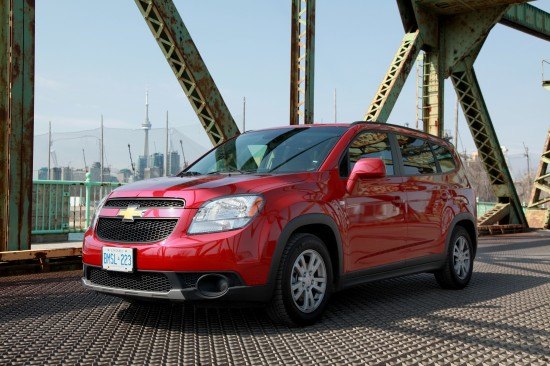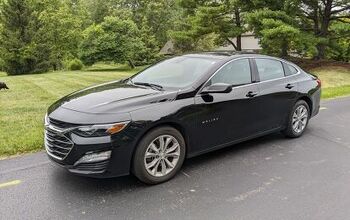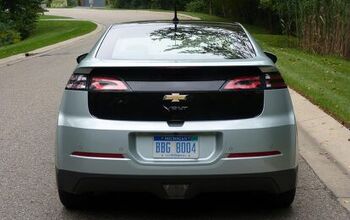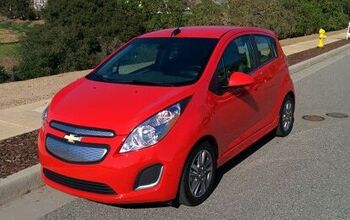Review: Chevrolet Orlando
It’s not often that automakers go to the trouble of bringing a car to Canada, but refrain from selling it in the United States. With one tenth the population and different homologation laws than the United States, the costs rarely make it worthwhile for automakers to import unique products to the Canadian market.
Minivans may be considered “uncool” by some, but they’ve yet to lose their luster up here. The Dodge Grand Caravan is one of Canada’s best-selling vehicles, and starts at the bargain basement price of $19,995 – identical to the Orlando. The similarities end there, as the Orlando is more a re-incarnation of the first generation Odyssey than a successor to the dreadful Uplander minivan that most of us have erased from our memories.
Like the old Odyssey, the Korean-built Orlando has conventionally hinged doors, a 4-cylinder engine and a smaller footprint than most traditional minivans. The Orlando, at 183 inches long, is nearly two feet shorter than a Grand Caravan and is 669 lbs lighter. The Orlando’s lack of heft means it feels like a big Cruze behind the wheel, with the same well-weighted but somewhat vague steering and relatively car-like driving dynamics. A 2.4L Ecotec engine and 6-speed automatic transmission are employed here, and while they feel slightly taxed in this application, the Orlando has enough power to get out of its own way. Pity that the GM 6-speed automatic still feels as if it’s on a 5-second delay to catch any instances of vehicular obscenity, as it spoils what could otherwise be a well-matched powertrain. Fuel economy around town was about 23 mpg, or 1 mpg better than GM’s city rating (supposedly it will return 34 mpg on the highway). A manual transmission is available, but the market for this unit is probably smaller than those Canadians who favor privatized healthcare or more lax gun laws.
The cabin of our tester was utilitarian, with all-black fabric and black plastic surfaces throughout our 2LT tester. The dash is basically identical to the Cruze, and all the controls will be familiar to anyone who has been in a recent GM product. One neat feature is a hinged stereo faceplate that can flip upwards to reveal a hidden storage compartment – great for cell phones, iPods and other gadgets. The seat fabric appears to be some kind of easy-to-clean material rather than plush cloth, likely a concession to owners who will want to clean up spilled apple juice rather than luxuriate in some fine imported fabric.
What the Orlando adds on the “car” side of the equation, it lacks on the “utility vehicle” side. There is no fancy stow-and-go seating arrangement like the Caravan, just conventional folding seats in the second row. The third row is very tight and suitable only for small kids. Owners would frankly be better off folding them flat, which opens up a much larger cargo area that would easily swallow up a couple suitcases.
Sales of the Orlando haven’t been that brisk, with the Mazda5 outselling it by over 100 units so far in 2012, and the Caravan comprising 60 percent of the total minivan market. The Caravan’s Stow ‘N Go seats, and the ability to swallow multiple hockey bags (thanks to the Caravan’s larger size) and identical pricing – both base models start at $19,995, and a Caravan with Stow ‘N Go starts at $23,995, while our Orlando 2LT starts at $500 less. The Orlando’s car-like nature made it easy to park and maneuver in the tight confines of downtown Toronto, and was able to haul myself, 4 friends and a dog around with ease on a weekend jaunt to a local park. But with most minivan buyers residing in the suburbs and ferrying multiple kids to school, hockey and all points in between, it’s easy to see why a traditional minivan may suit their needs better than the Orlando, despite the Chevrolet’s merits.
More by Derek Kreindler
Latest Car Reviews
Read moreLatest Product Reviews
Read moreRecent Comments
- BlackEldo Why even offer a Murano? They have the Rogue and the Pathfinder. What differentiates the Murano? Fleet sales?
- Jalop1991 Nissan is Readying a Slew of New Products to Boost Sales and ProfitabilitySo they're moving to lawn and garden equipment?
- Yuda I'd love to see what Hennessy does with this one GAWD
- Lorenzo I just noticed the 1954 Ford Customline V8 has the same exterior dimensions, but better legroom, shoulder room, hip room, a V8 engine, and a trunk lid. It sold, with Fordomatic, for $21,500, inflation adjusted.
- Lorenzo They won't be sold just in Beverly Hills - there's a Nieman-Marcus in nearly every big city. When they're finally junked, the transfer case will be first to be salvaged, since it'll be unused.
























































Comments
Join the conversation
reminds me of a 4 door geo tracker. anyone have an idea as to how these 2 diff models compare in length and width?
Literally registered for the site to comment on the review. This is the first time I've truly seen a detailed photo catalogue of a car that wasn't sh**. Great job!! I now have a great idea of what the car looks like inside and out..